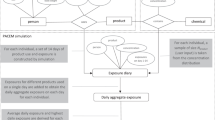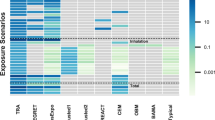Abstract
Consumer product categorizations for use in predicting human chemical exposure provide a bridge between product composition data and consumer product use pattern information. Furthermore, the categories reflect other factors relevant to developing consumer product exposure scenarios, such as microenvironment of use (e.g., indoors or outdoors), method of application/form of release (e.g., spray versus liquid), release to various media, removal processes (e.g., rinse-off or wipe-off), and route-specific exposure factors (dermal surface areas of application, fraction of release in respirable form). While challenging, developing harmonized product categories can generalize the factors described above allowing for rapid parameterization of route-specific exposure scenario algorithms for new chemical/product applications and efficient utilization of new data on product use or composition. This can be accomplished via mapping product categories to likewise categorized release and use patterns or exposure factors. Here, hierarchical product use categories (PUCs) for consumer products that provide such mappings are presented and crosswalked with other internationally harmonized product categories for consumer exposure assessment. The PUCs were defined by applying use and exposure scenario information to the products in EPA’s Chemical and Products Database (CPDat). This paper demonstrates how these PUCs are being used to rapidly parameterize algorithms for scenario-specific use, fate, and exposure in a probabilistic aggregate model of human exposure to chemicals used in consumer products. The PUCs provide a generic representation of consumer products for use in exposure assessment and provide an efficient framework for flexible and rapid data reporting and consumer exposure model parameterization.
This is a preview of subscription content, access via your institution
Access options
Subscribe to this journal
Receive 6 print issues and online access
$259.00 per year
only $43.17 per issue
Buy this article
- Purchase on Springer Link
- Instant access to full article PDF
Prices may be subject to local taxes which are calculated during checkout


Similar content being viewed by others
Code availability
All code for the CHEM model is available at https://github.com/HumanExposure
References
National Research Council. Exposure science in the 21st century: a vision and a strategy. Washington, D.C.: National Academies Press; 2012.
National Academies of Sciences. Using 21st century science to improve risk-related evaluations. Washington, D.C.: National Academies of Sciences; 2017.
Dellarco M, Zaleski R, Gaborek BJ, Qian H, Bellin CA, Egeghy P, et al. Using exposure bands for rapid decision making in the RISK21 tiered exposure assessment. Crit Rev Toxicol. 2017;47:317–41.
Meek ME, Boobis AR, Crofton KM, Heinemeyer G, Raaij MV, Vickers C. Risk assessment of combined exposure to multiple chemicals: a WHO/IPCS framework. Regul Toxicol Pharmacol. 2011;60:S1–14.
Uniform Code Council. Universal product code: industrial and commercial guidelines. Dayton, OH: The Council; 1992.
Eurostat. Prodcom—Statistics by Product http://ec.europa.eu/eurostat/web/prodcom/overview.
European Chemical Agency. Guidance on information requirements and chemical safety assessment. Helsinki, Finland: European Chemical Agency; 2015.
United States Environmental Protection Agency (Office of Pollution Prevention and Toxics). Instructions for Reporting: 2016 TSCA Chemical Data Reporting, https://www.epa.gov/sites/production/files/2016-05/documents/instructions_for_reporting_2016_tsca_cdr_13may2016.pdf. 2016.
Goldsmith MR, Grulke CM, Brooks RD, Transue TR, Tan YM, Frame A, et al. Development of a consumer product ingredient database for chemical exposure screening and prioritization. Food Chem Toxicol: Int J published Br Ind Biol Res Assoc. 2014;65:269–79.
Isaacs KK, Glen WG, Egeghy P, Goldsmith MR, Smith L, Vallero D, et al. SHEDS-HT: an integrated probabilistic exposure model for prioritizing exposures to chemicals with near-field and dietary sources. Environ Sci Technol. 2014;48:12750–9.
Organisation for Economic Co-operation and Development. Internationally harmonised functional product and article use categories ENV/JM/MONO (2017)14. Organisation for Economic Co-operation and Development; 2017.
Little JC, Weschler CJ, Nazaroff WW, Liu Z, Cohen Hubal EA. Rapid methods to estimate potential exposure to semivolatile organic compounds in the indoor environment. Environ Sci Technol. 2012;46:11171–8.
US EPA Office of Research and Development. Beta version of the Human Exposure Model (HEM) for Consumer Products 2018. Available from: https://github.com/HumanExposure.
National Research Council. Models in environmental regulatory decision making. Washington, D.C: National Academies Press; 2007.
National Institute for Public Health and the Environment. ConsExpo. Available from: https://www.rivm.nl/en/Topics/C/ConsExpo.
US EPA Office of Pollution Prevention and Toxics. Consumer Exposure Model (CEM) Version 2.0 (https://www.epa.gov/sites/production/files/2017-06/documents/cem_2.0_user_guide.pdf). 2016.
Baptista ML, Martinho CR, Lima F, Santos PA, Prendinger H. An agent-based model of consumer behavior based on the BDI architecture and neoclassical theory. Developments in business simulation and experiential learning. 2014;41:170–8.
Roozmand O, Ghasem-Aghaee N, Hofstede GJ, Nematbakhsh MA, Baraani A, Verwaart T. Agent-based modeling of consumer decision making process based on power distance and personality. Knowl-Based Syst. 2011;24:1075–95.
Mitchell J, Arnot JA, Jolliet O, Georgopoulos PG, Isukapalli S, Dasgupta S, et al. Comparison of modeling approaches to prioritize chemicals based on estimates of exposure and exposure potential. Sci Total Environ. 2013;458-460:555–67.
Dimitroulopoulou C, Trantallidi M, Carrer P, Efthimiou GC, Bartzis JG. EPHECT II: exposure assessment to household consumer products. Sci Total Environ. 2015;536:890–902.
Zaleski RT, Qian H, Zelenka MP, George-Ares A, Money C. European solvent industry group generic exposure scenario risk and exposure tool. J Exposure Sci Environ Epidemiol. 2014;24:27–35.
Dionisio KL, Phillips K, Price PS, Grulke C, Williams A, Biryol D, et al. The Chemical and Products Database, a resource for exposure-relevant data on chemicals in consumer products. Scientific Data. 2018;5:1–9.
US EPA Office of Pollution Prevention and Toxics. Approaches to estimate consumer exposure under TSCA. Washington, D.C.: US EPA Office of Pollution Prevention and Toxics; 2018.
Brandon N, Dionisio K, Isaacs K, Tornero-Velez R, Kapraun D, Setzer W, et al. Simulating exposure-related behaviors using agent-based models embedded with needs-based artificial intelligence. J Exposure Sci Environ Epidemiol. 2018 [Epub ahead of print].
Williams AJ, Grulke CM, Edwards J, McEachran AD, Mansouri K, Baker NC, et al. The CompTox Chemistry Dashboard: a community data resource for environmental chemistry. J Cheminformatics. 2017;9:61.
EPA CompTox Chemicals Dashboard registration at FAIRsharing.org. Available from: https://fairsharing.org/FAIRsharing.tfj7gt.
Acknowledgements
We thank Drs. Dan Vallero and Steven Prince and Ms. Tanya Spero for helpful technical review of this manuscript. The views expressed in this article are those of the authors and do not necessarily represent the views or policies of the U.S. Environmental Protection Agency.
Author information
Authors and Affiliations
Corresponding author
Ethics declarations
Conflict of interest
The authors declare that they have no conflict of interest.
Additional information
Publisher’s note Springer Nature remains neutral with regard to jurisdictional claims in published maps and institutional affiliations.
Supplementary Information
Rights and permissions
About this article
Cite this article
Isaacs, K.K., Dionisio, K., Phillips, K. et al. Establishing a system of consumer product use categories to support rapid modeling of human exposure. J Expo Sci Environ Epidemiol 30, 171–183 (2020). https://doi.org/10.1038/s41370-019-0187-5
Received:
Revised:
Accepted:
Published:
Issue Date:
DOI: https://doi.org/10.1038/s41370-019-0187-5
Keywords
This article is cited by
-
PACEMweb: a tool for aggregate consumer exposure assessment
Journal of Exposure Science & Environmental Epidemiology (2023)
-
Implementing a suspect screening method to assess occupational chemical exposures among US-based hairdressers serving an ethnically diverse clientele: a pilot study
Journal of Exposure Science & Environmental Epidemiology (2023)
-
Exposure forecasting – ExpoCast – for data-poor chemicals in commerce and the environment
Journal of Exposure Science & Environmental Epidemiology (2022)
-
Environmental mixtures and breast cancer: identifying co-exposure patterns between understudied vs breast cancer-associated chemicals using chemical inventory informatics
Journal of Exposure Science & Environmental Epidemiology (2022)
-
Perspectives on advancing consumer product exposure models
Journal of Exposure Science & Environmental Epidemiology (2020)



